The old village of Châteauneuf dominates the surrounding countryside of Auxois in Burgundy in a picturesque setting. The village, which is part of the association Les Plus Beaux Villages de France, has kept the powerful castle flanked by massive towers. Following our visit, I propose you discover this beautiful site of Burgundy in pictures!
A beautiful stay in Burgundy
As a teenager, our family had stayed in Semur-en-Auxois. We passed by a village founded a long time during an excursion to Beaune.
I remember very well this magnificent site, this village and its castle perched on a promontory above the Burgundian countryside.
Already fond of old stones, I told myself that later – as an adult – I would return to explore this site.
And so it is much later that I had the opportunity!
During our last stay in Meursault.
On a beautiful sunny day, I took the car for a bit of excursion to Châteauneuf, accompanied by Aimée (then six years old).
We were not disappointed with the trip.
And it’s finally time to publish a complete report of our visit!
Which Chateauneuf are we talking about?
Small warning before continuing…
Let’s not get the wrong Châteauneuf !
Châteauneuf is the name of about thirty communes in France, including the famous Châteauneuf-du-Pape between Orange and Avignon (Vaucluse).
Across the Burgundy region, three localities bear the same name:
- in Côte d’Or,
- in Sâone-et-Loire,
- and in the Nièvre (Châteauneuf-Val-de-Bargis).
It is customary to add -en-Auxois to Châteauneuf in the Côte d’Or, so as not to confuse the commune with another!
The arrival in Châteauneuf in Burgundy
As it should be, I had planned in advance the road I wanted to take to reach the village.
A book had given me some clues to discover the village from far. After some research on Google Maps, I found the exact location of the photo I wanted to reproduce. And I’m going to let you in on the secret!
On the road to Bouhey
I arrived from the south, on the D18.
In the village of Crugey, you have to turn right in the direction of Bouhey. The small departmental road D18B makes its way through the fields while taking height.
In Bouhey, don’t make a mistake and take the direction of Châteauneuf by a very small tarred road “Sous les roches”. After a passage in the forest, it leads to the fields. And from there, the sight is seizing! One must stop to admire the beautiful countryside of the Country of Auxois.

In the background, the view on the promontory of Châteauneuf is magnificent. Like in a beautiful book!
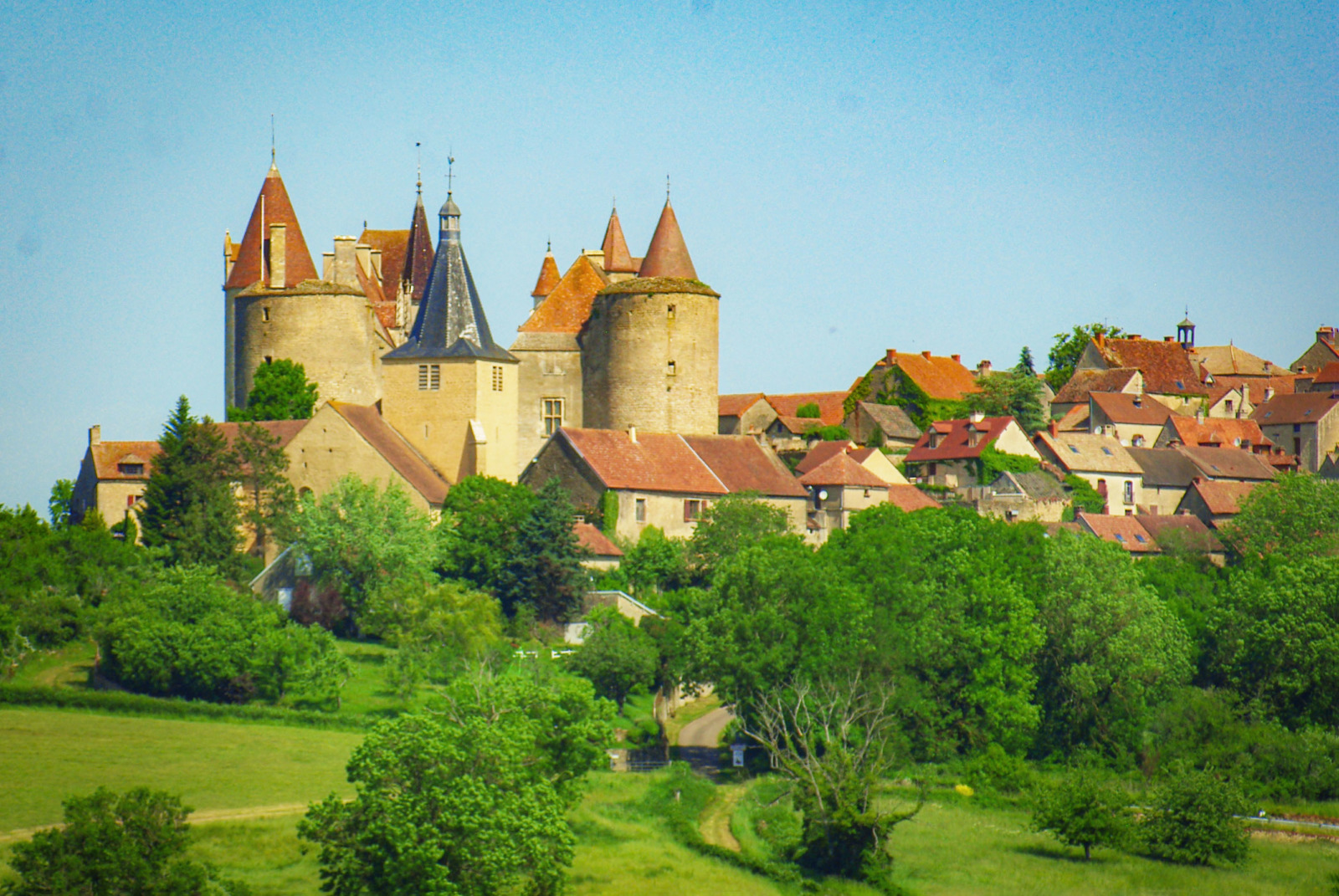
Moreover, this road is ideal for Sunday cyclists…
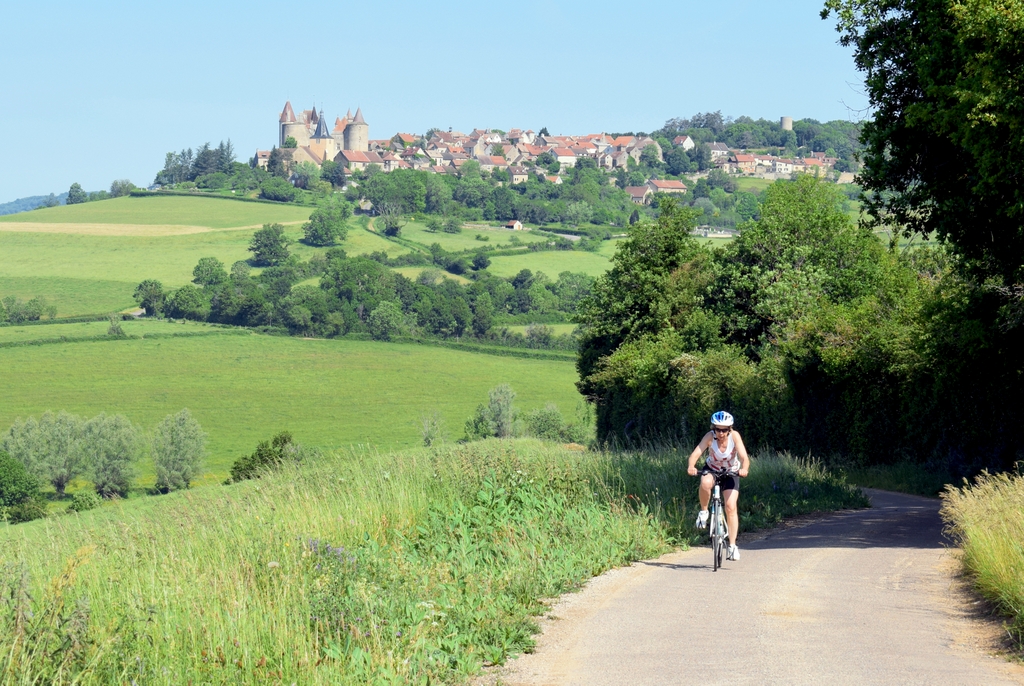
The road joins the D18A, which goes up to Châteauneuf (on the right). All that remains is to find a parking place.
I had planned to park in the parking lot outside the village for visitors… but I changed my mind when I crossed Châteauneuf because there were several free places in the marketplace. It couldn’t be more central!
The castle of Châteauneuf
The castle of Châteauneuf stands on a rocky promontory at an altitude of 475 meters. The fortress dominates the Vandenesse valley, where the Burgundy canal and the A6 freeway pass.
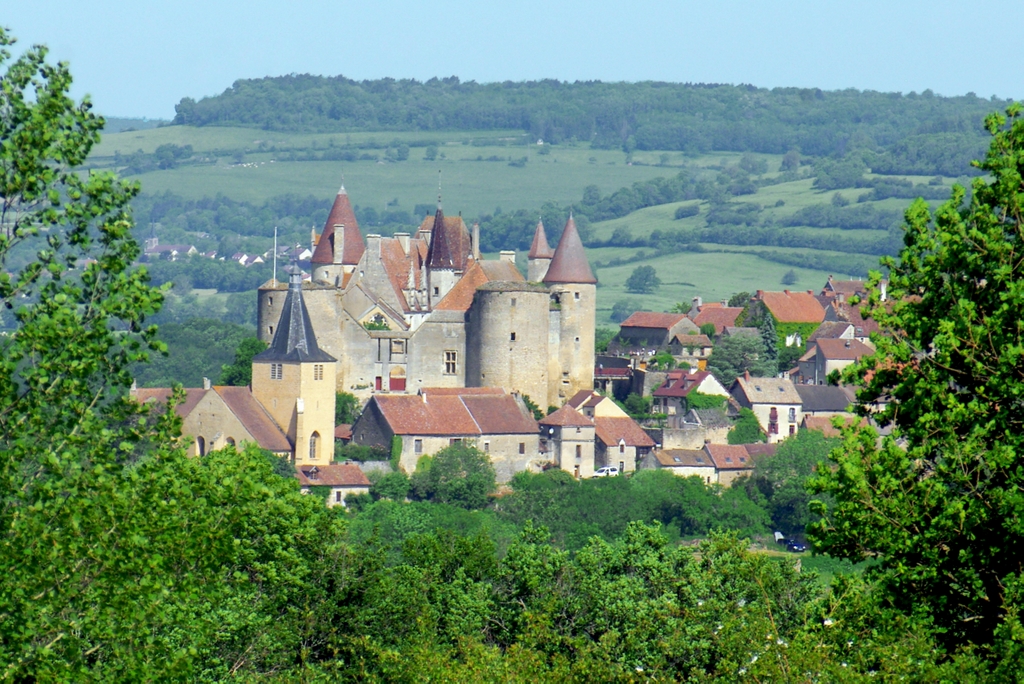
At the origin of the castle
In the second half of the 12th century, Jean de Chaudenay created the seigneury of Châteauneuf and then gave it to his youngest son, Jean. He and his successors defended their seigneury above all with their castle, one of the masterpieces of Burgundian military architecture.
Its polygonal walls, built in the 13th century, surround the square keep with five circular towers (75 m long and 35 m wide).

The poisoner who made Philippe Pot happy
When the 15th-century chatelaine, Catherine de Châteauneuf, was found guilty of having poisoned her husband’s flanks with arsenic, Philippe le Bon, Duke of Burgundy, confiscated her castle in 1457 and gave it to his courtier, Philippe Pot (1428-1493).
It is to Philippe Pot that we owe the transformations of the 15th century. Châteauneuf became a residence of pleasure.
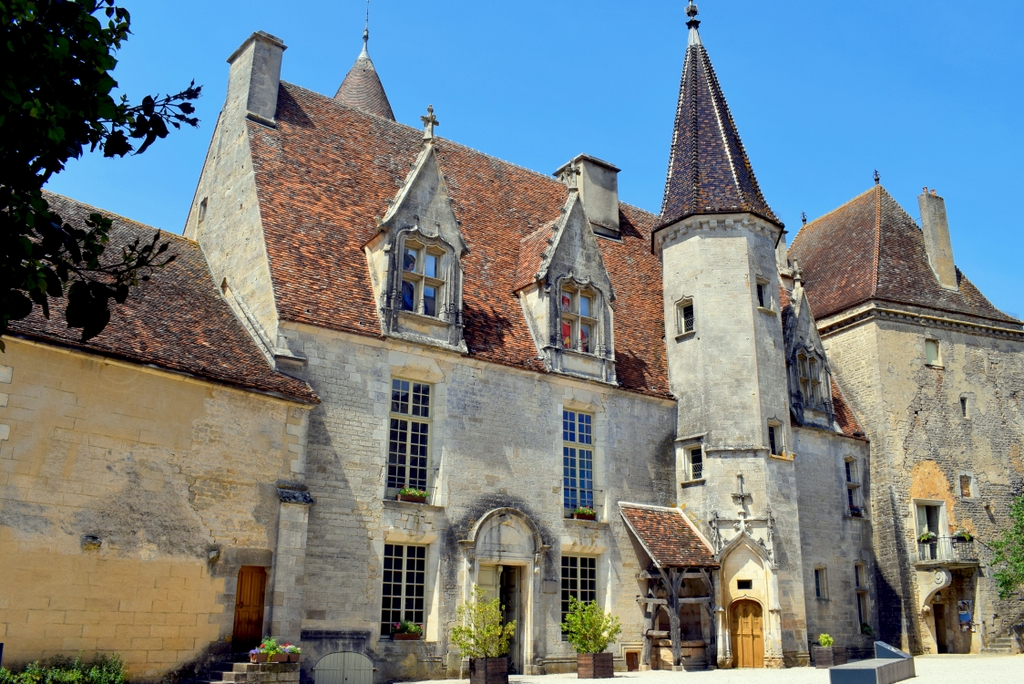
Philippe Pot was the owner of the castle of La Rochepot, a knight of the Golden Fleece and a supporter of the King of France. Louis XI later gave him the title of seneschal of France.
The prestige at the court of the king of France allowed him to have the necessary funds to embellish his castle of Châteauneuf. Nevertheless, of his two living quarters, built in the 15th century, the eastern one is now in ruins.
The castle’s Gothic chapel, with a contemporary mural depicting Jesus and his apostles, also dates from Philip’s time.

From the 16th century to today
In 1551, it was Anne de Montmorency who inherited the castle from his mother, Anne, niece of Philippe Pot. He became a constable (i.e. commander of the French king’s armies) and owned large estates in the Ile de France: Ecouen and Chantilly.

Then, in 1627, Charles de Vienne and his wife Marguerite bought the castle and moved into the keep. Their successors built small apartments on the second floor of the large dwelling.
At the beginning of the 19th century, the castle became the property of the de Vogüe family. It was bequeathed to the French state in 1936, which in 2008 gave it to the Burgundy Region (now Burgundy-Franche-Comté).
Visit the castle
You can visit the castle and discover the chapel and other very interesting rooms.
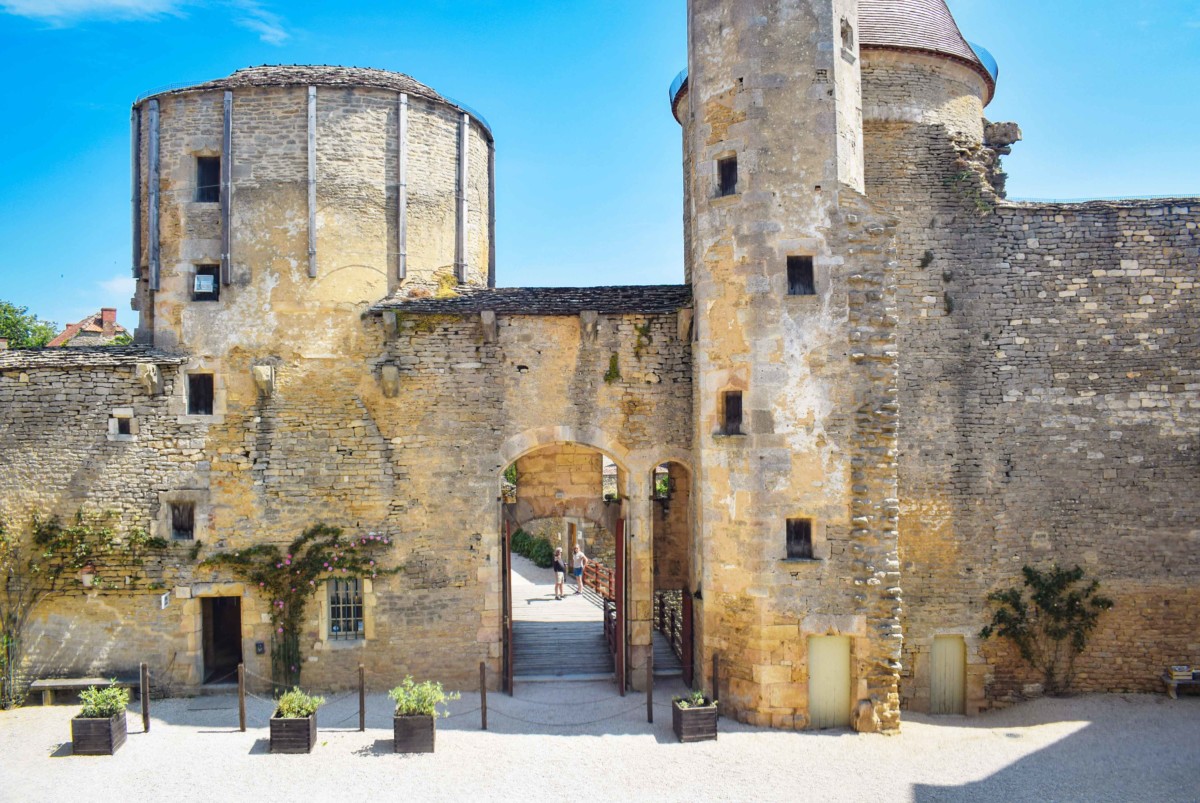
After crossing the moat, you enter through a large fortified gate. The reception and the store are on the right.

The inner courtyard gives access to the Grand Logis and the other buildings of the castle.


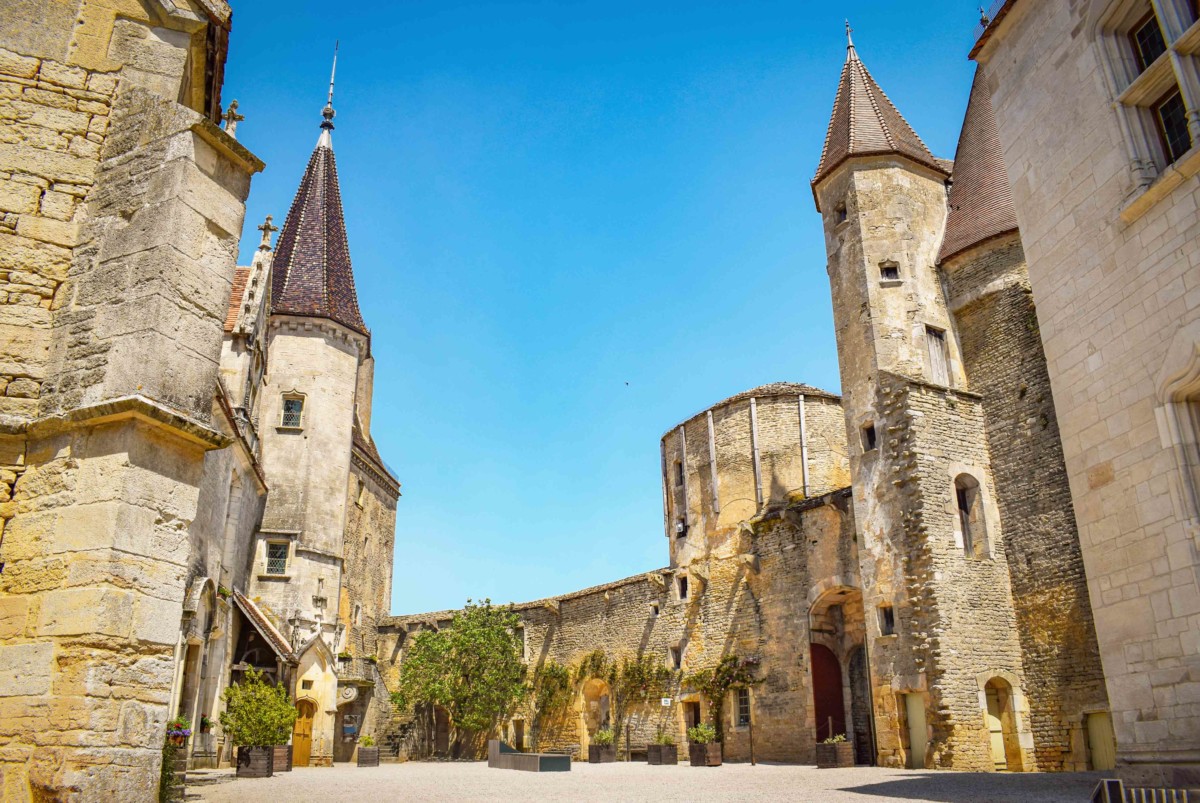
The Grand Logis is composed of several rooms and apartments, including the chapel.
The great hall was built in the main house by Philippe Pot at the end of the 15th century. It was used as a ceremonial room for public meetings, receptions and banquets. Philippe Pot’s motto “Tant L Vault” is visible on the fireplace. It refers to the Virgin Mary (Tant Elle Vaut).
The private apartment of a lord of the 1480s-1500s on the second floor of the Grand Logis.
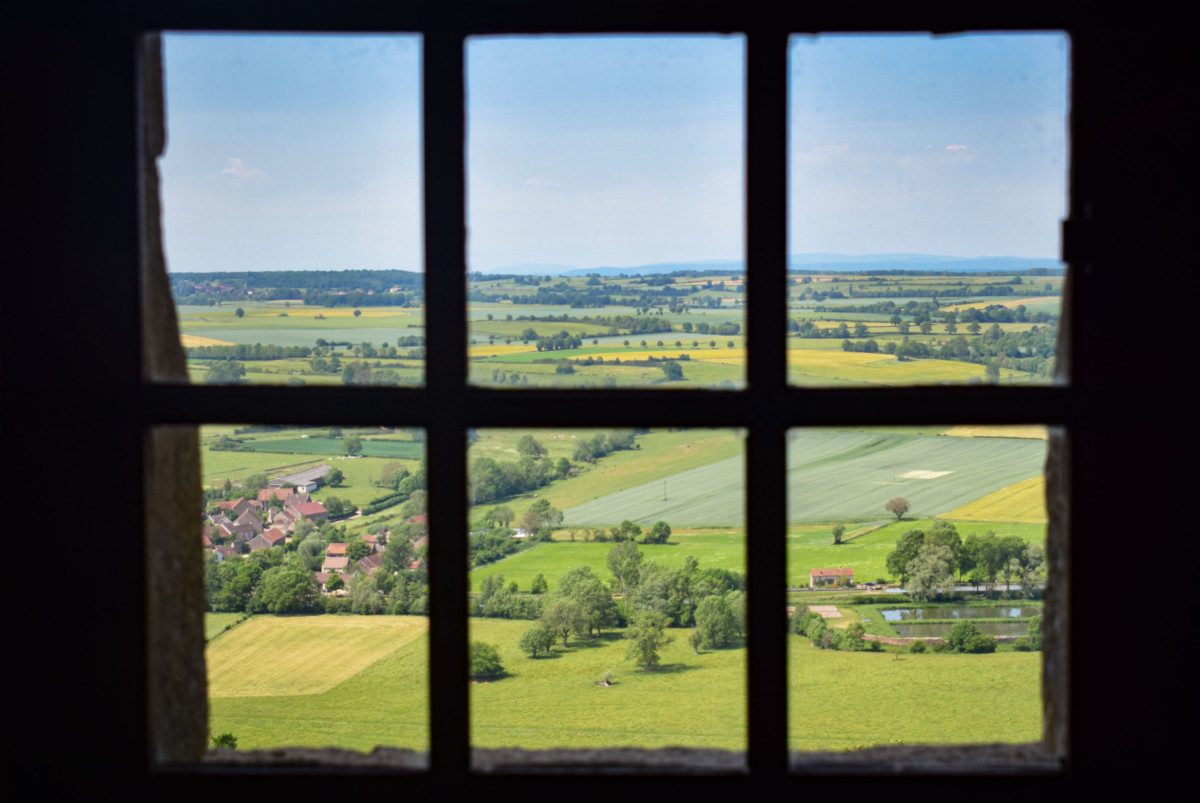
The Vienne room, on the second floor of the square tower, is located in the oldest part of the castle (12th-13th centuries).
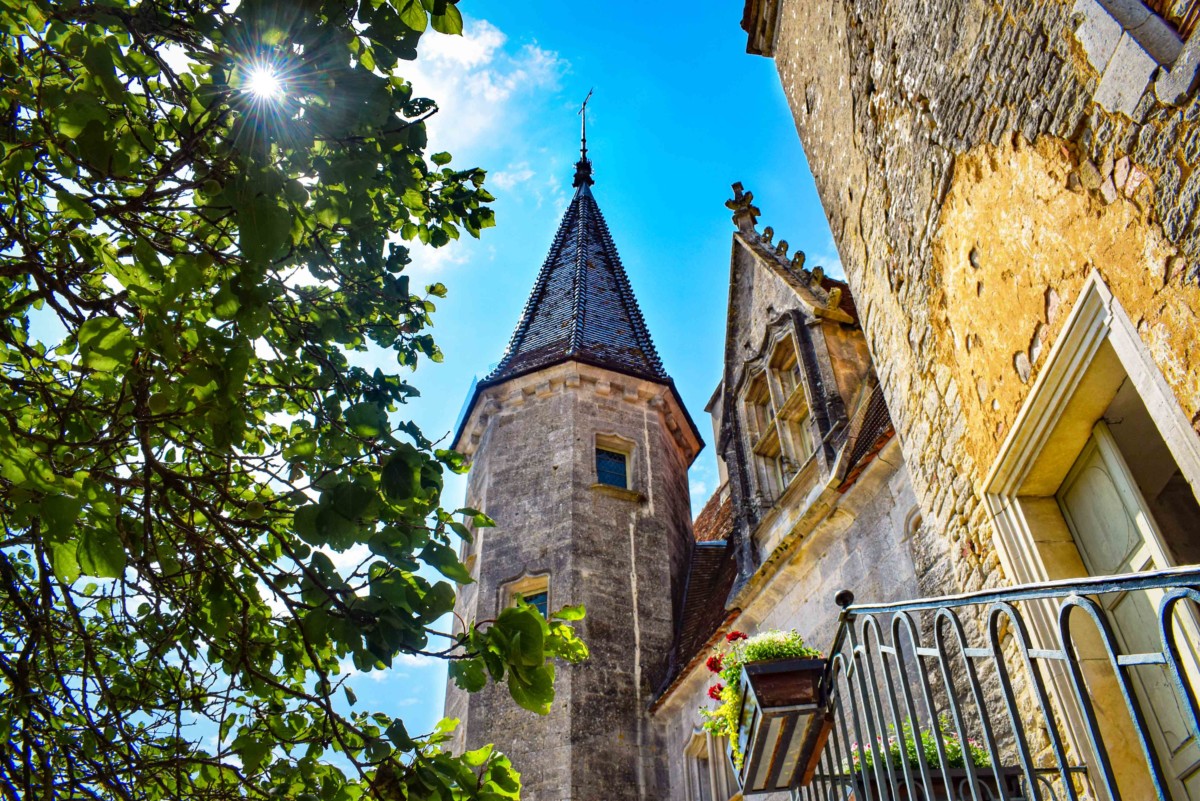
The southwest tower was an integral part of the 14th-century enclosure and ensured the defence of the curtain walls.
The visit to the village of Châteauneuf in Auxois
At the top of the hill, the castle defends the attractive village which was once surrounded by walls.
Châteauneuf is intimately linked to the presence of the castle. The village is laid out in a regular plan around the Grande Rue and the rue du Centre whose houses date from the 14th to the 18th century.

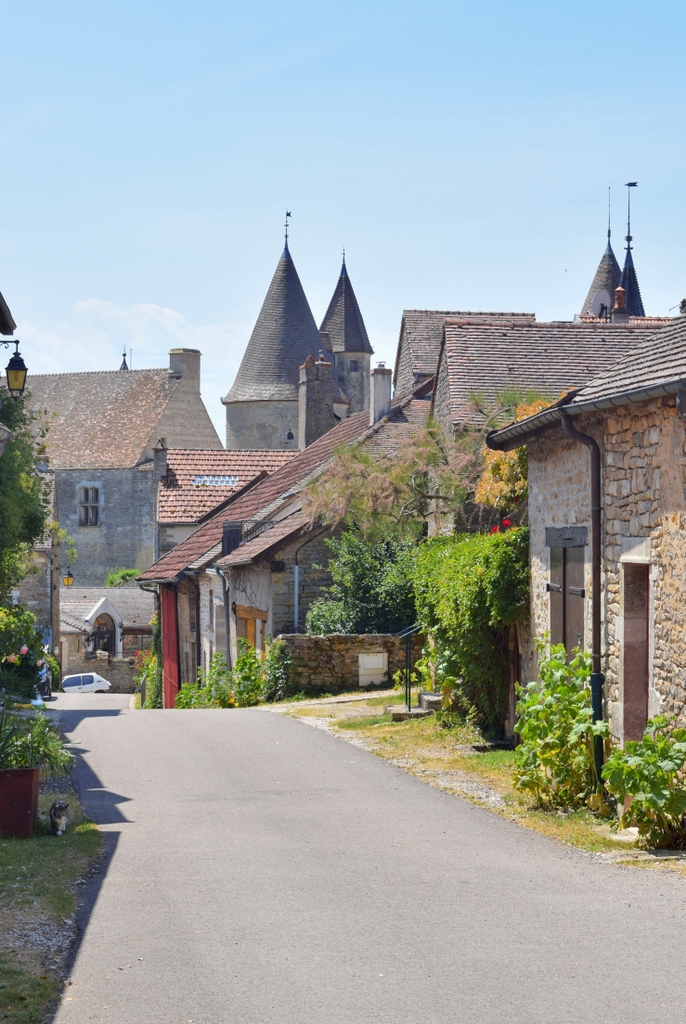
As for the big fairs of the past, they are evoked here by names such as the Grange aux ânes (Donkey Barn), la place aux bœufs (Ox Square), la place aux chevaux (Horse Square), la place du marché (Market Square), la place aux cochons (Pig Square) et la place aux moutons (Sheep Square).
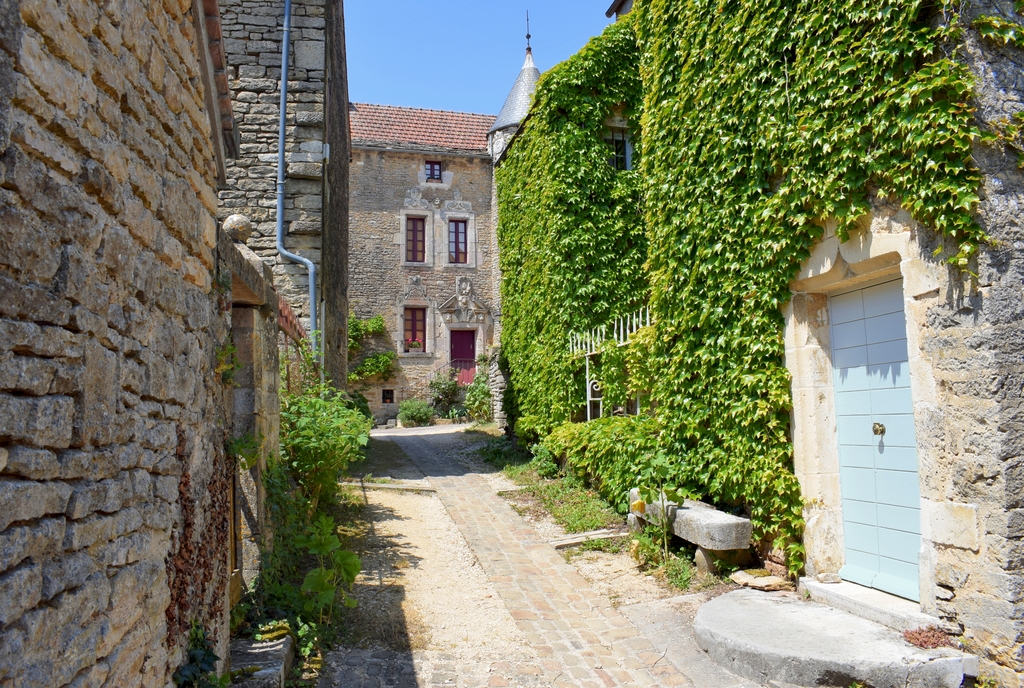
The (brief) history of the village
The prosperity of Châteauneuf peaked from the second half of the 15th century to the end of the 16th century.
However, the industrial revolution and its consequences (the rural exodus) strongly affected the development of the village. There were 523 inhabitants in 1806 and only 62 in 1982. In 2018, the population has risen slightly to 82. The development of tourism since the 1960s has helped to restore the village’s standing.
In 1970, the surroundings of Châteauneuf experienced a profound change in the landscape with the opening of the A6 Paris-Lyon highway. The castle, clearly visible from the motorway, reminds passing motorists of the popular image of the Middle Ages, with its defensive towers and walls.

Today, the village of Châteauneuf is a member of the association Les Plus Beaux Villages de France.
In 2021, the village of Châteauneuf was the candidate of the Burgundy-Franche-Comté region for the television contest Le Village préféré des Français, hosted by Stéphane Bern.

Some bourgeois houses in Châteauneuf
Some houses have stair towers, others bear on their pediment the sculptures of the coat of arms of those who owned them.
La Maison au Mouton
Dominating the Grande Rue is a more important house, whose old round tower evokes the nobility of its former occupants. It is the “Maison au Mouton” (Sheep House), from the end of the 16th century.
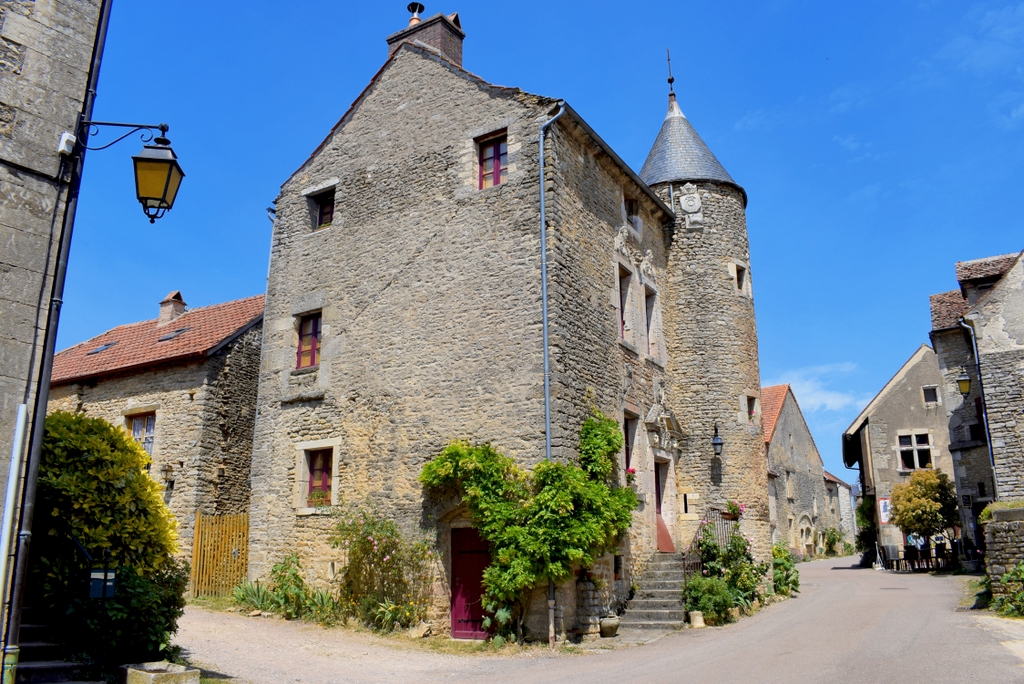
It takes its name from the sculpted relief of the sundial of 1588 which represents a sheep.
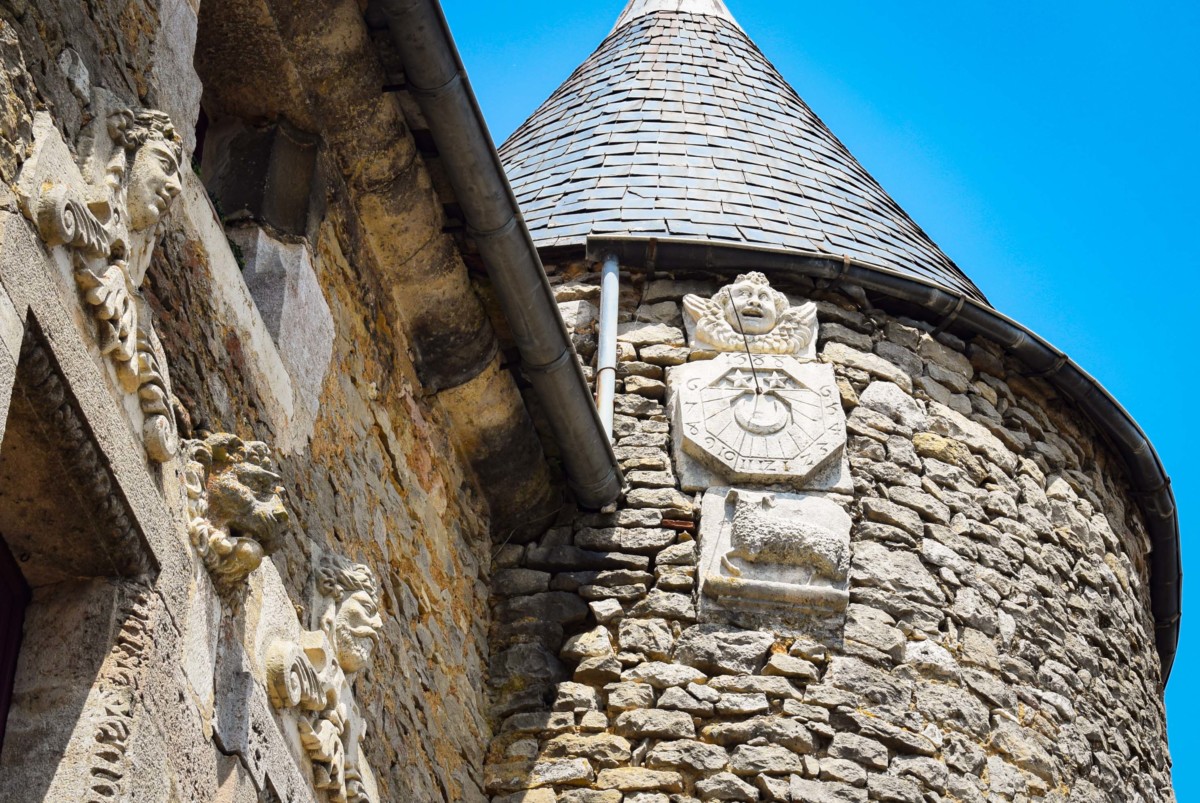
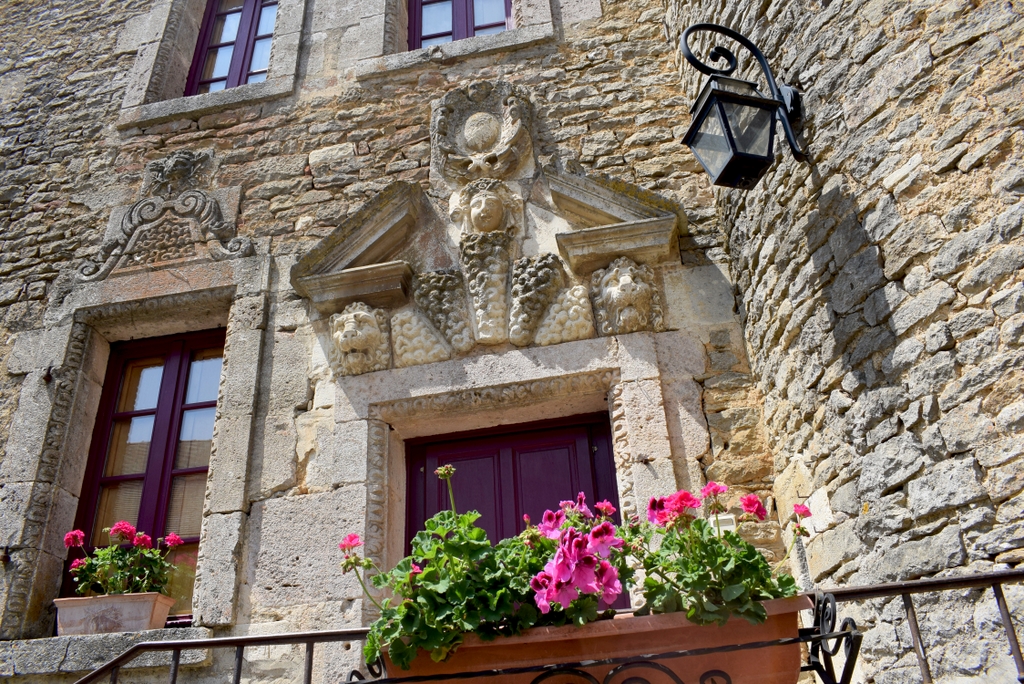
La Maison avec Tourelle
The neighbouring house, with its turret, dates from around 1550.
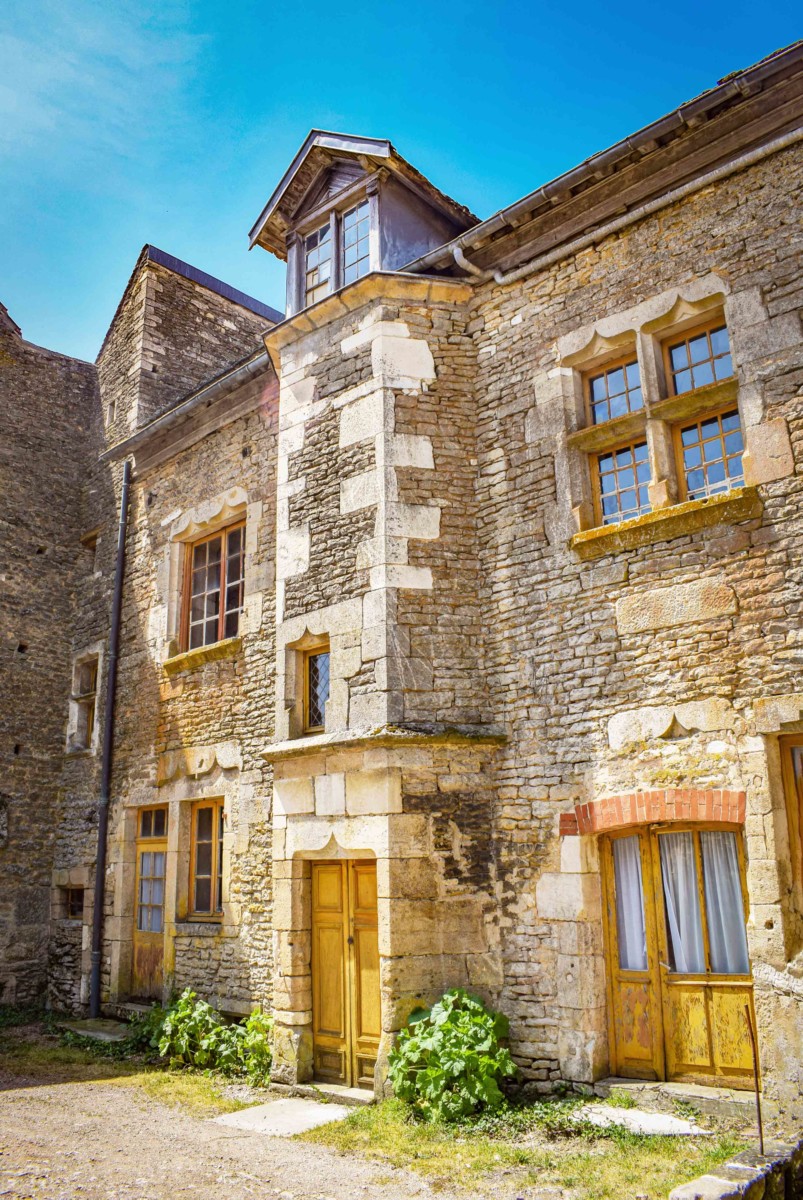
It is a typical example of a late medieval bourgeois house. Its architecture is still medieval with a large opening with mullion and crosspieces, moulded lintels and the stair turret projecting from the facade.
The only half-timbered house
Only one half-timbered house remains in the village today.
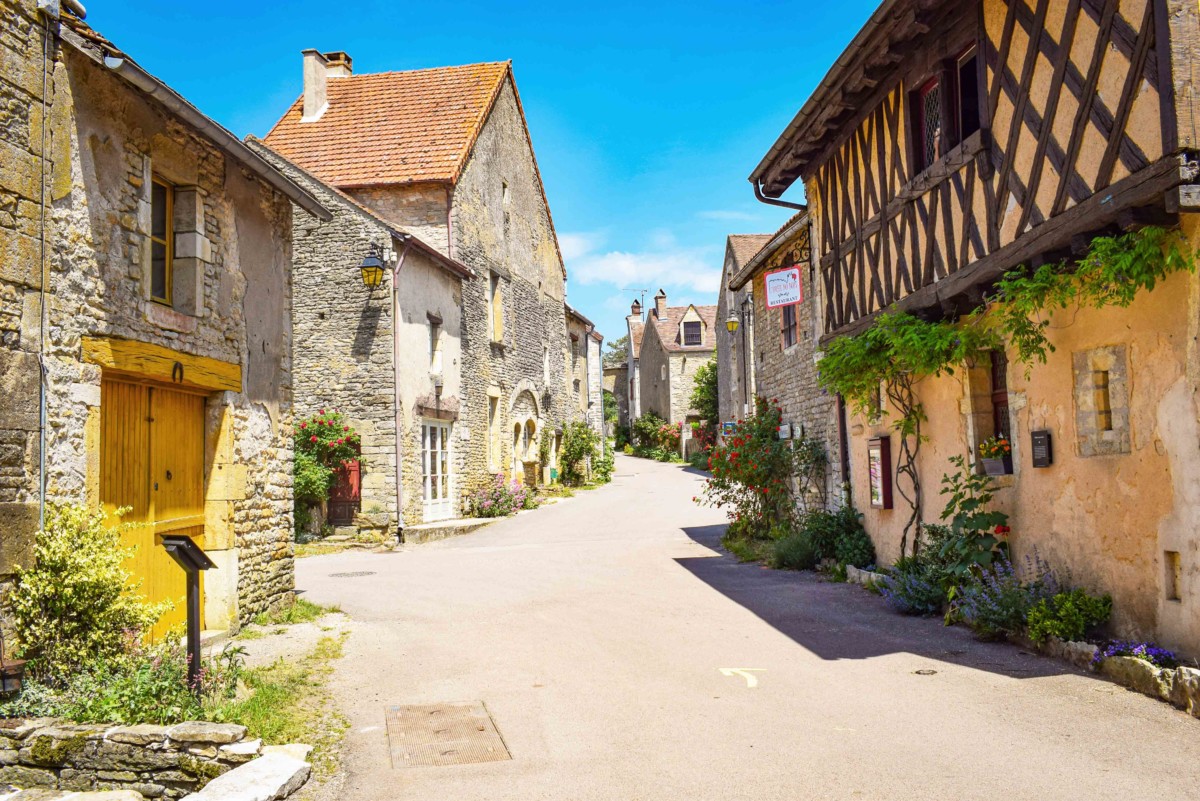
It dates back to the 15th century and still preserves some elements of medieval architecture (lintel on the door, gable side). The half-timberings are on the second floor and represent crosses of Saint Andrew.
The Bichot house
This house, built in 1588, belonged to one of the oldest and most notable families of Châteauneuf, ennobled in 1629. The facade is composed of an eaves wall pierced by a door covered with a semicircular arch and several bays.
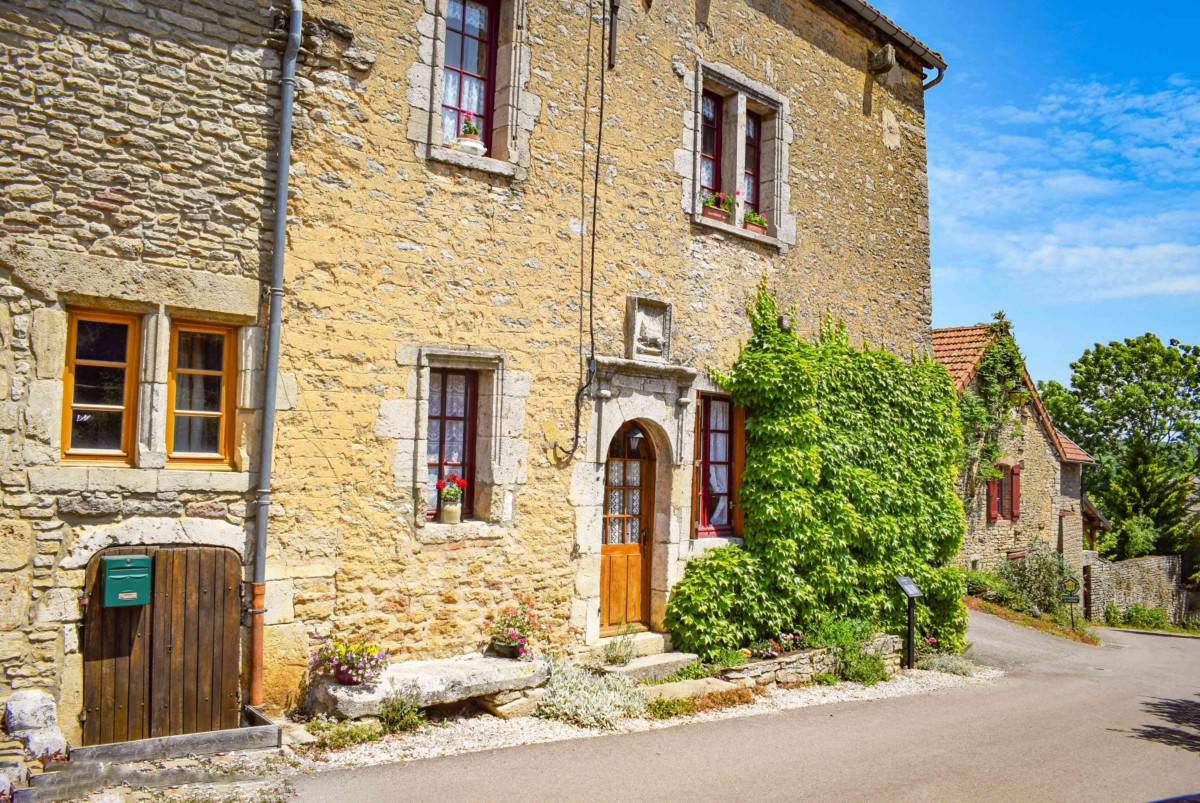
The coat of arms above the door represents the “talking arms” of the Bichot family: a doe and a bone!

And pretty flowers on the stone bench at the entrance of the house:

The house on the Place aux Porcs
This stone house located in front of the castle is typical of late medieval townhouses. Modest in size, it has the first floor for commercial purposes and one room per floor.
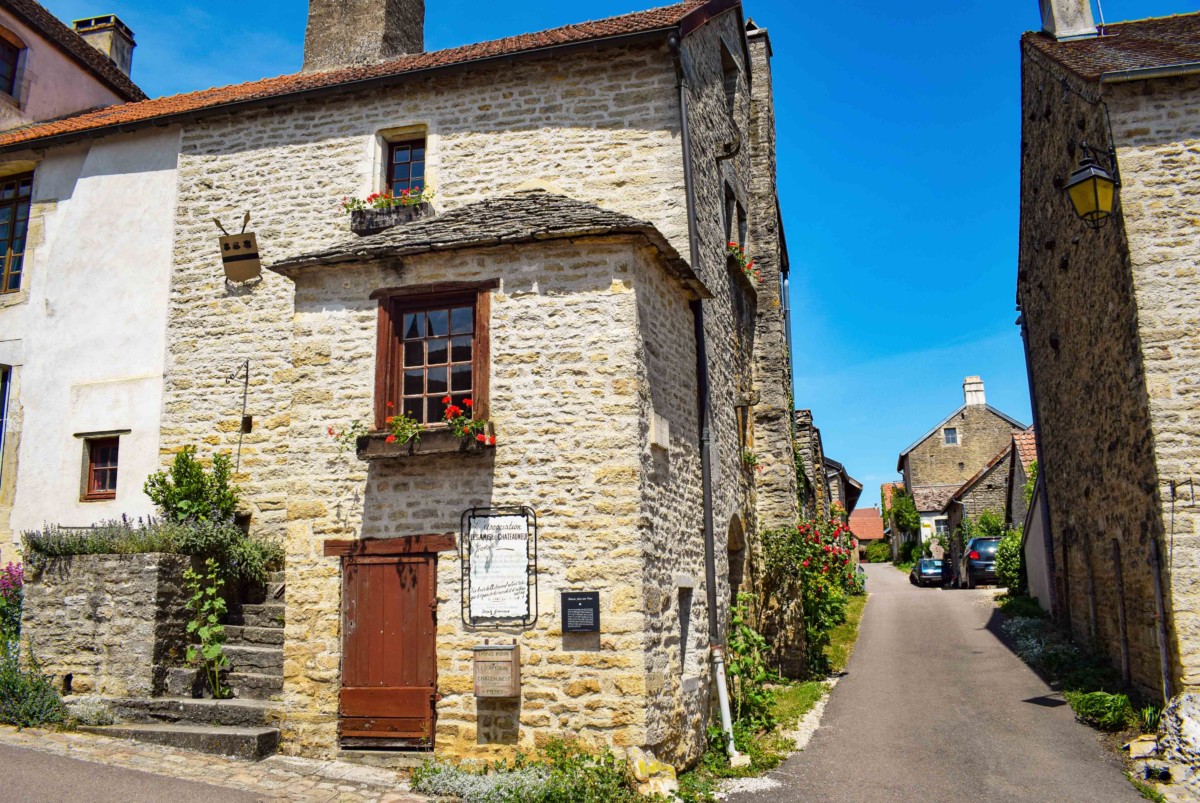
As for the façade on the street side (the gable façade), it has a beautiful cellar door with three arches, characteristic of storage cellars. On the second floor, the geminated window allowed for the lighting of the residential part of the house.
The Saint-Philippe-et-Saint-Jacques church
The parish church of Châteauneuf, dating from the end of the 15th century, has a massive bell tower, built in 1526, destroyed by lightning in 1779 and rebuilt.
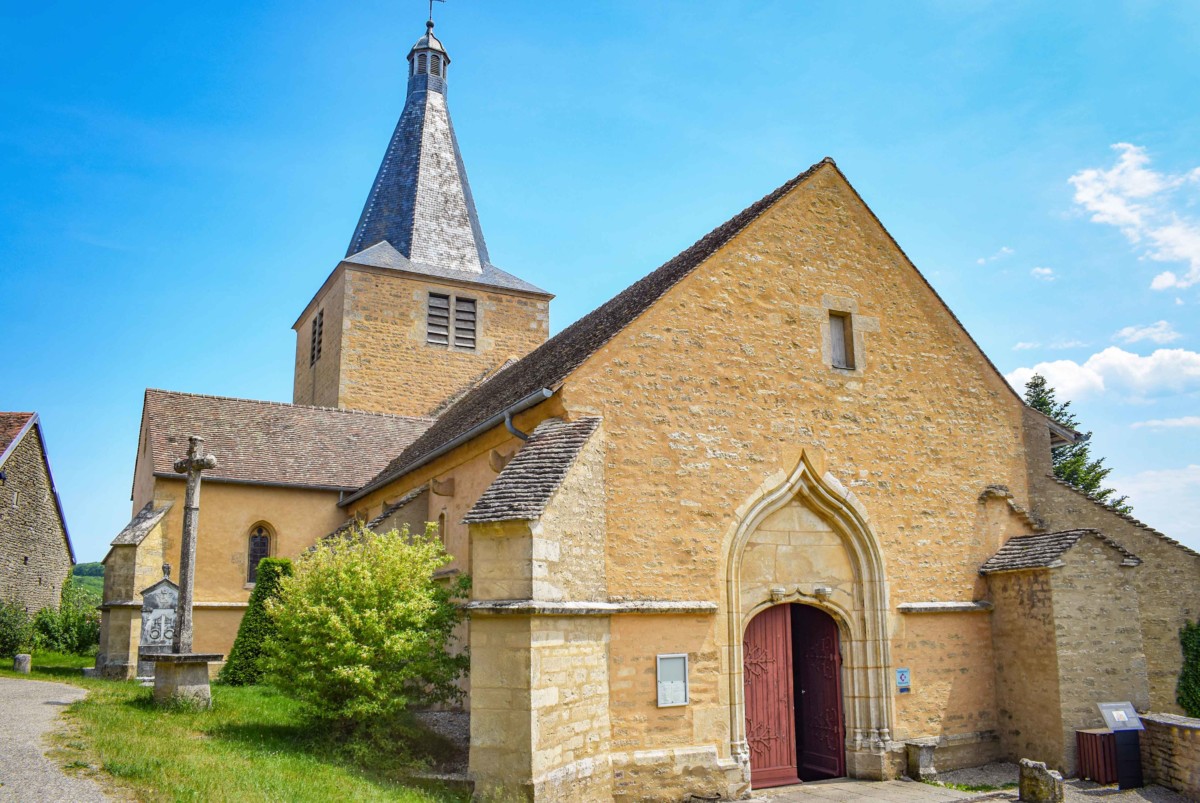
Inside, the nave is covered with ribbed windows and flanked by two chapels opening onto a third bay: the Saint-Joseph (or Lords) chapel to the north and the Notre-Dame-du-Chêne (formerly Saint-Jean) chapel to the south.

The pulpit, in the Burgundian style, dates from 1538. Its Renaissance decoration includes six panels representing prophets from the Bible.
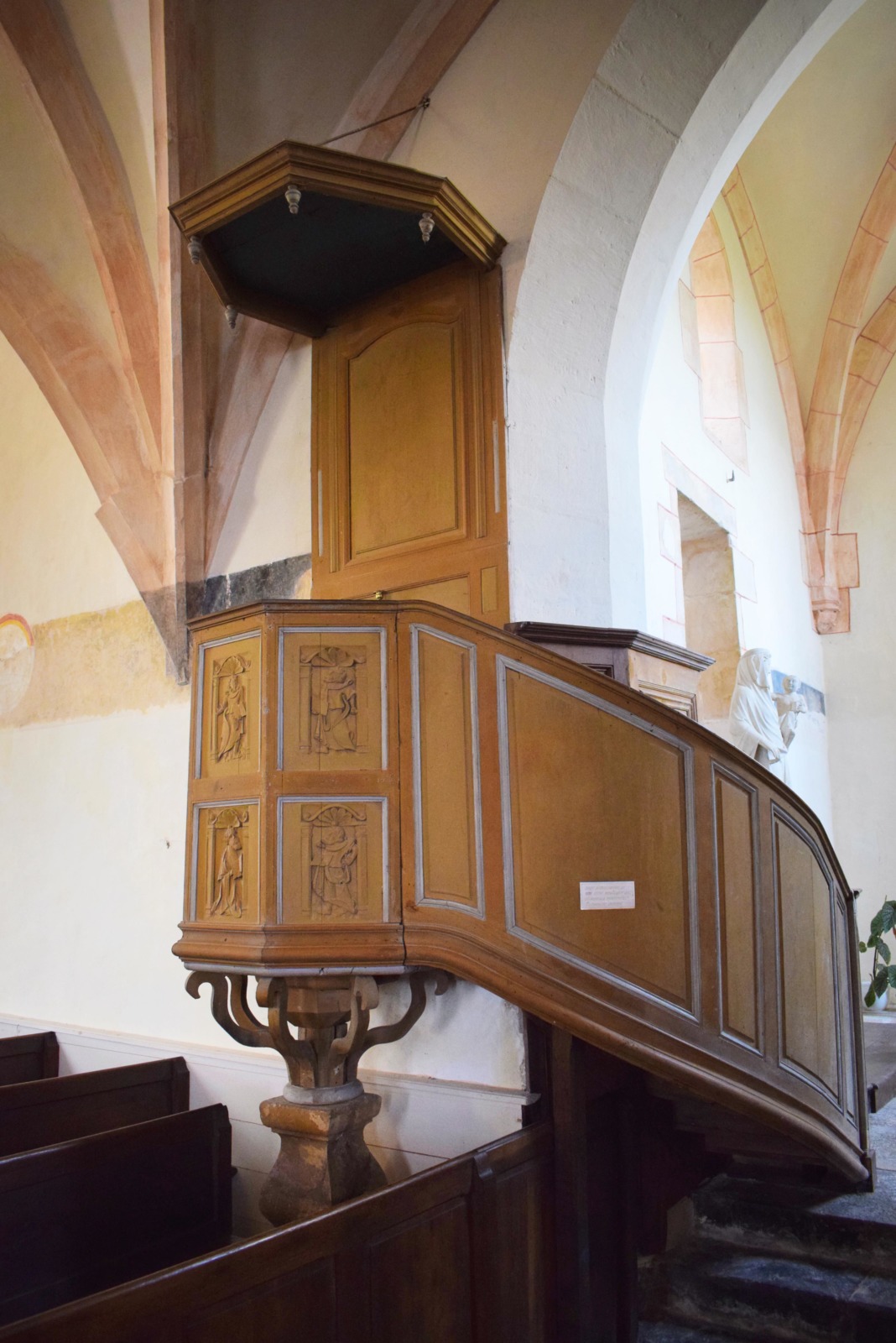
The statues of the church
The church is known for the richness and splendour of its statuary.

A statue of the Virgin and Child or the Virgin and Bird dates back to the middle of the 14th century.
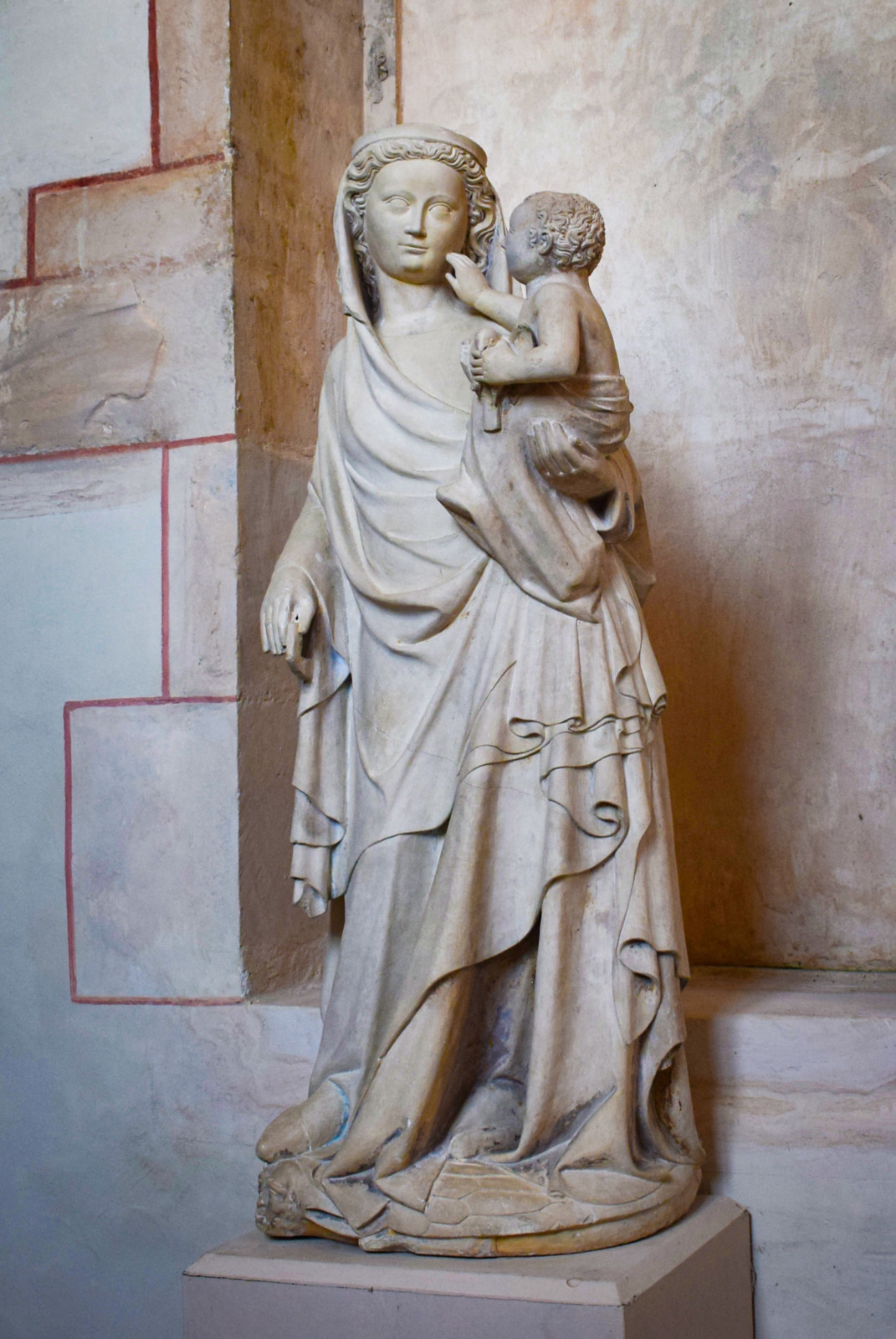
Previously coloured, the statue is made of Burgundy limestone. Its style is typically Burgundian by the way Mary holds her child on her hip.
The child is holding a bird in her hand that is biting her finger. This bird could be a finch, which is the symbol of the Passion. This may explain why the child is caressing the gentle face of his Mother.
Other statues include a magnificent 15th century St. John the Baptist and a life-size 16th-century representation of St. Philip and St. James, patron saints of the church.
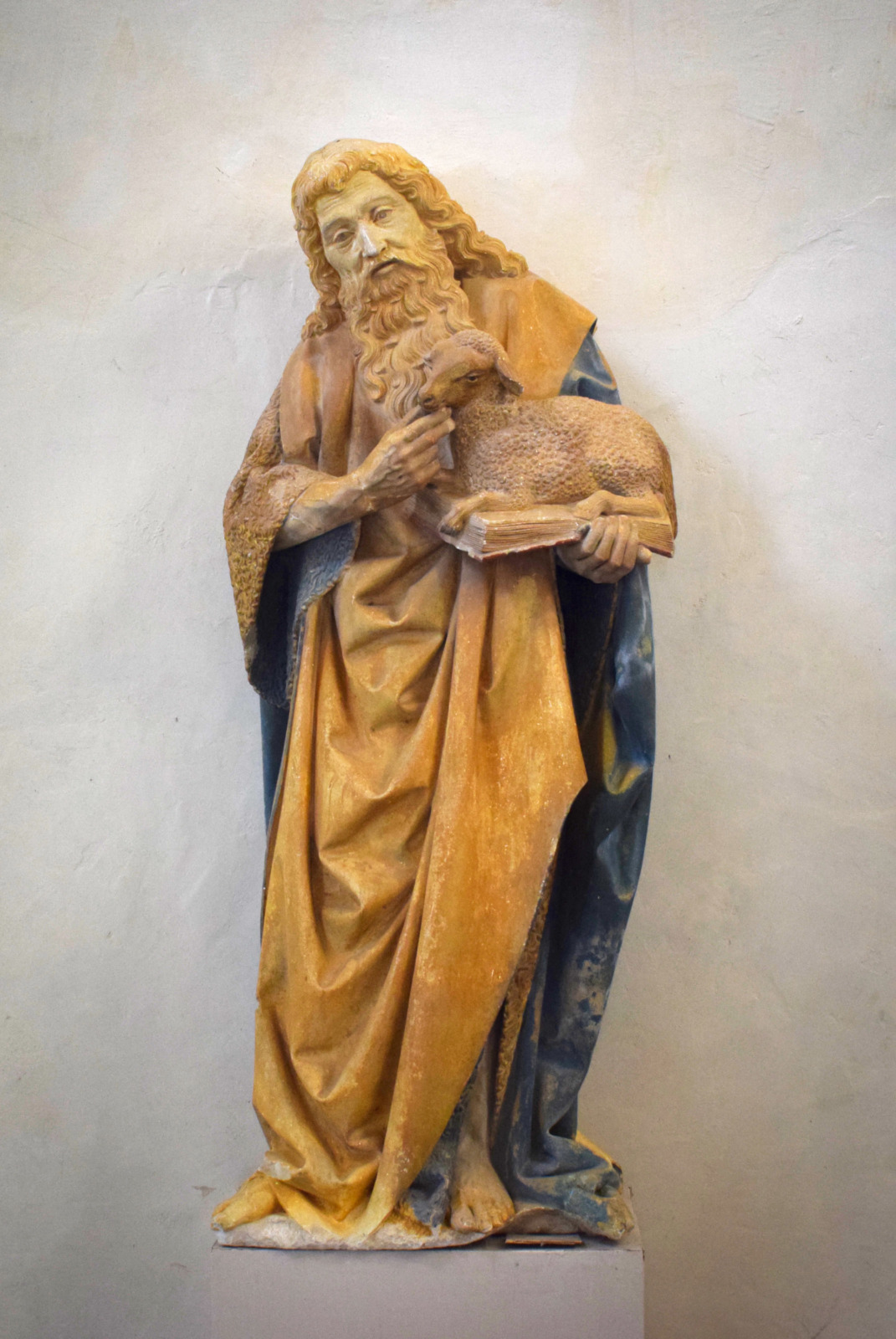
The north gate
This fortified gate of the Porte Nord (North Gate) dates back to 1582 and is one of the rare remains of the village’s fortifications.
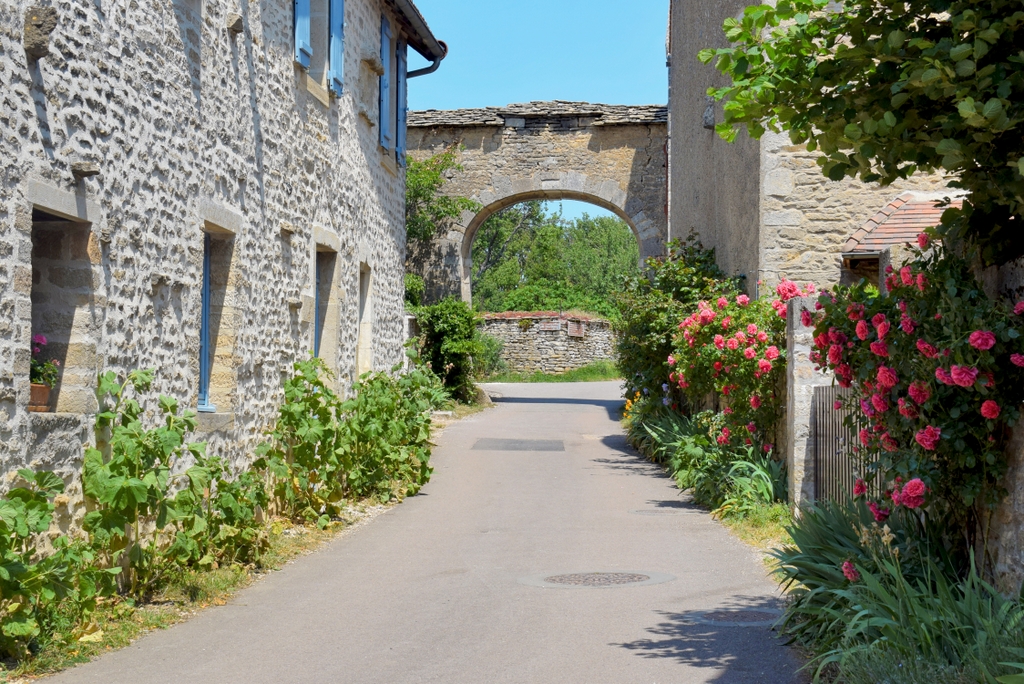
It bore the coat of arms and the motto of the Vienne family, then owner of the village. During the Revolution, it was removed and replaced by the inscription “Citoyens”.
Moreover, Châteauneuf took the name of Mont-Franc between 1792 and 1795.
The panorama of La Croix de Mission
From the viewpoint of “La Croix de Mission”, a superb panorama of the Vandenesse valley and the surrounding countryside.
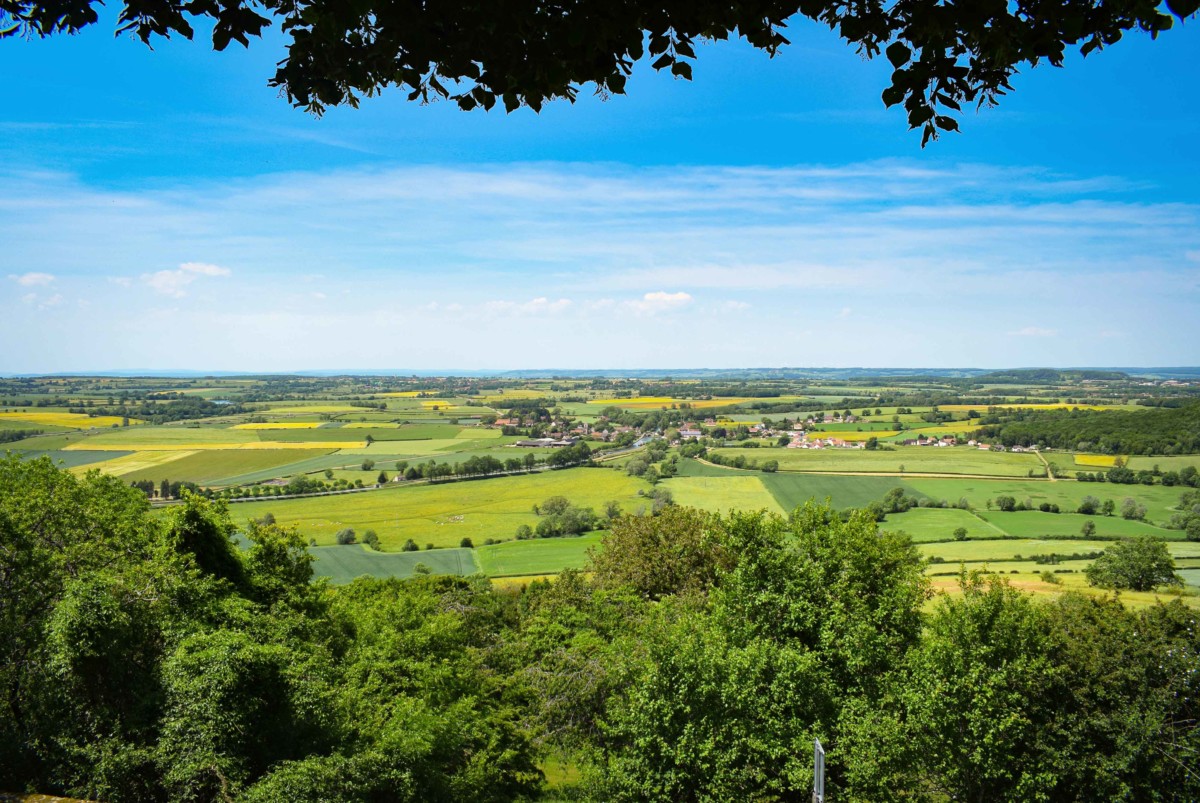
One can see the long ribbon of the A6 motorway and, in the background, the mountains of Morvan.
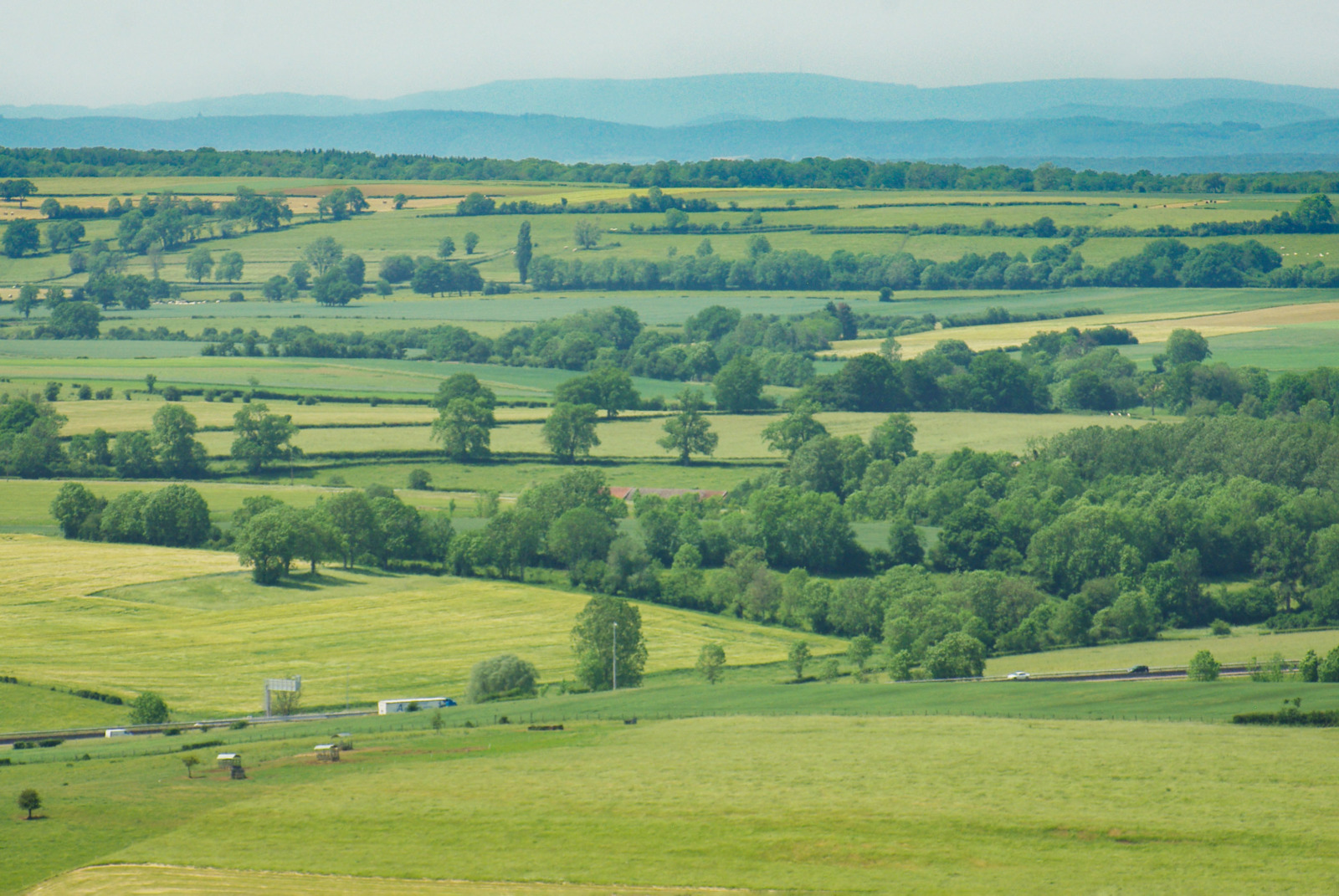
What to discover around Châteauneuf
Here are some ideas for excursions in Burgundy starting from Châteauneuf:
The port of Vandenesse
2.5 km to the west
It is pleasant to stroll along the marina of Vandenesse-en-Auxois.
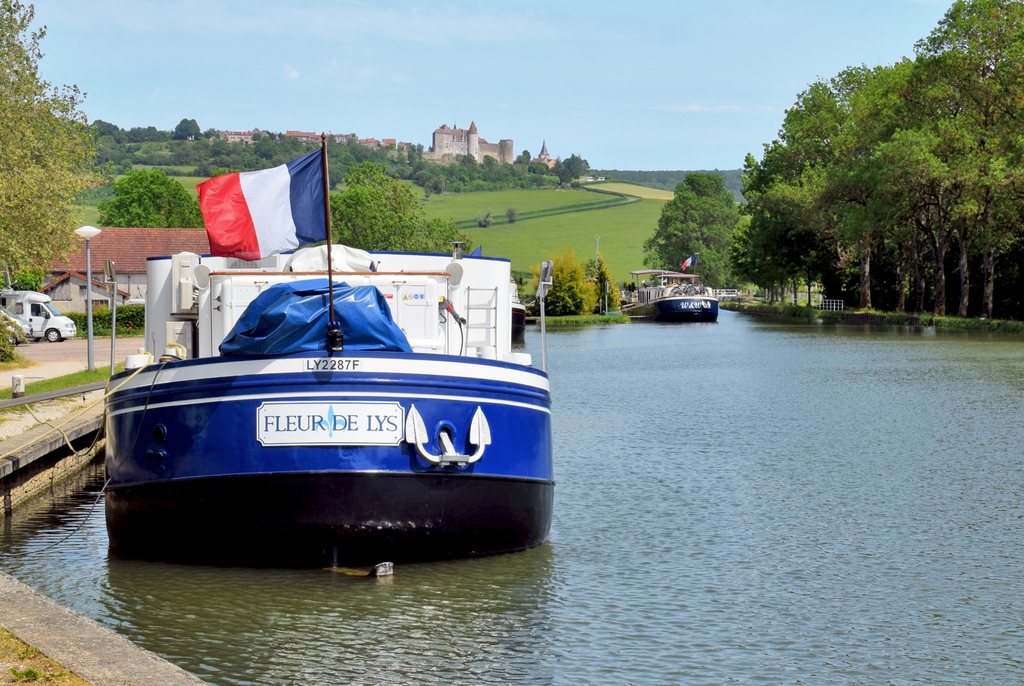
In the village, the parish church of Notre-Dame de l’Assomption dates back to the 12th century.
In the direction of Commarin, the lake of Panthier was created for the needs of the Burgundy canal in 1836. Today, it hosts a leisure centre, a campground and a sailing club.

A path goes around it in an easy walk.
The Burgundy canal
2,5 km to the northwest
Between Vandenesse-en-Auxois and the bridge of the A6 motorway, the Burgundy Canal (Canal de Bourgogne) offers splendid views of the site of Châteauneuf.

We discover the charming little houses of the lock keepers, some of which are abundantly decorated with flowers.

The castle of Commarin
5 km to the north-east
This neo-classical style castle, rebuilt in large part from 1702 to 1713, has kept the moat and the two round towers of the 14th-century feudal castle.
![The Château de Commarin © Christophe.Finot - license [CC BY-SA 2.5] from Wikimedia Commons](https://frenchmoments.eu/wp-content/uploads/2021/09/Chateau-de-Commarin-©-Christophe.Finot-licence-CC-BY-SA-2.5-from-Wikimedia-Commons.jpg)
The castle of Commarin can be visited and one can discover inside a unique collection of heraldic and alchemical tapestries of the 16th century, as well as interior decorations and furniture of the 17th and 18th centuries.
Semur-en-Auxois
50 km to the north
The small capital of the Auxois region is set up in a very picturesque site. The houses are hung on a cliff of pink granite dominating the ravine at the bottom of which flows the Armançon.
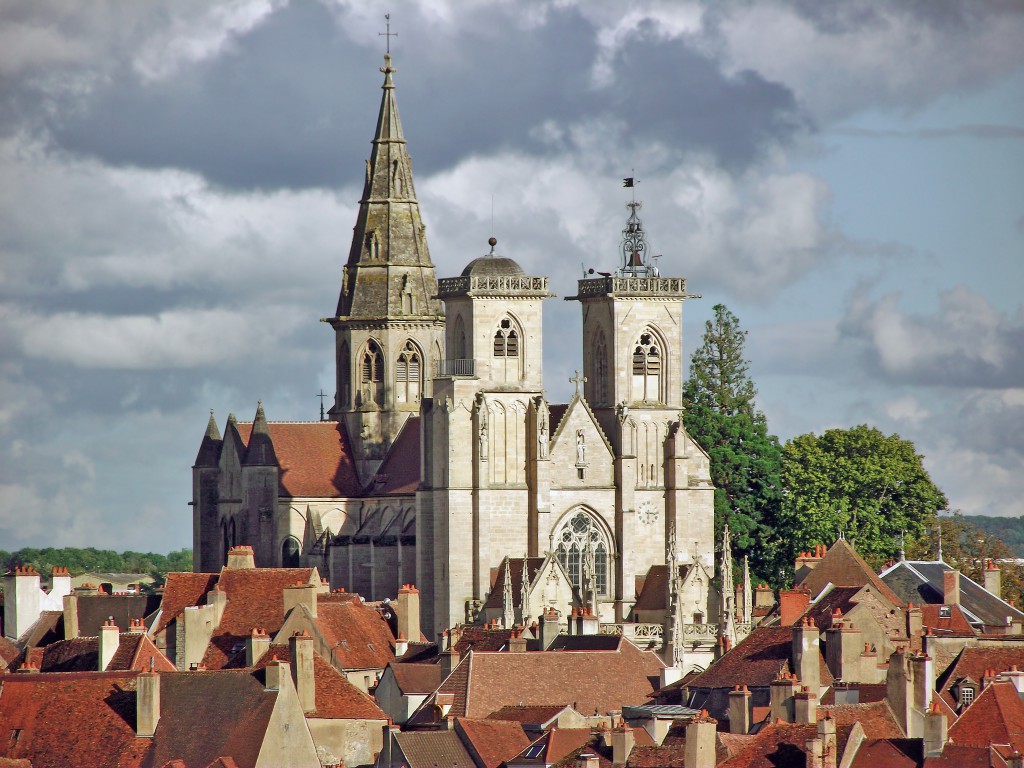
The old historical centre is dominated by the big towers of the keep and the tapered spire of the collegiate church of Notre Dame. Great view from the Pinard bridge!
![Semur-en-Auxois © Michel FOUCHER - licence [CC BY-SA 4.0] from Wikimedia Commons](https://frenchmoments.eu/wp-content/uploads/2021/09/Semur-en-Auxois-©-Michel-FOUCHER-licence-CC-BY-SA-4.0-from-Wikimedia-Commons.jpg)
Dijon
40 km to the east
The former capital of the dukes of Burgundy is a famous city of art.

Its historical centre is full of beautiful monuments: private mansions with glazed tiles, beautiful gothic churches, old half-timbered houses, without forgetting the ducal palace which borders the Liberation square.


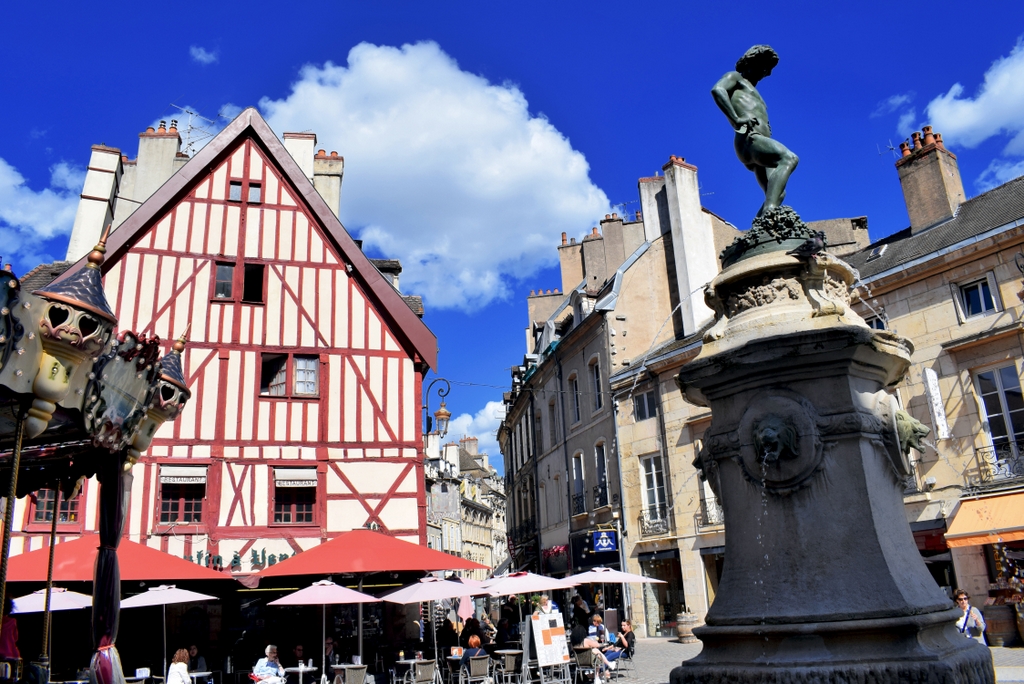
And, since we are in Burgundy, Dijon’s gastronomy is not to be outdone!
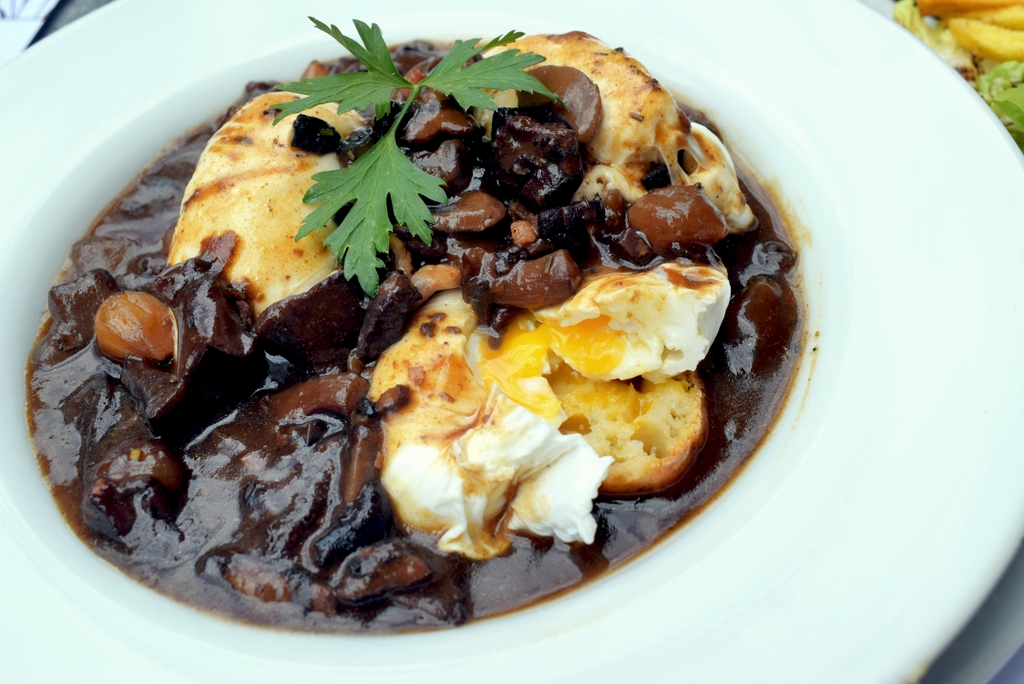
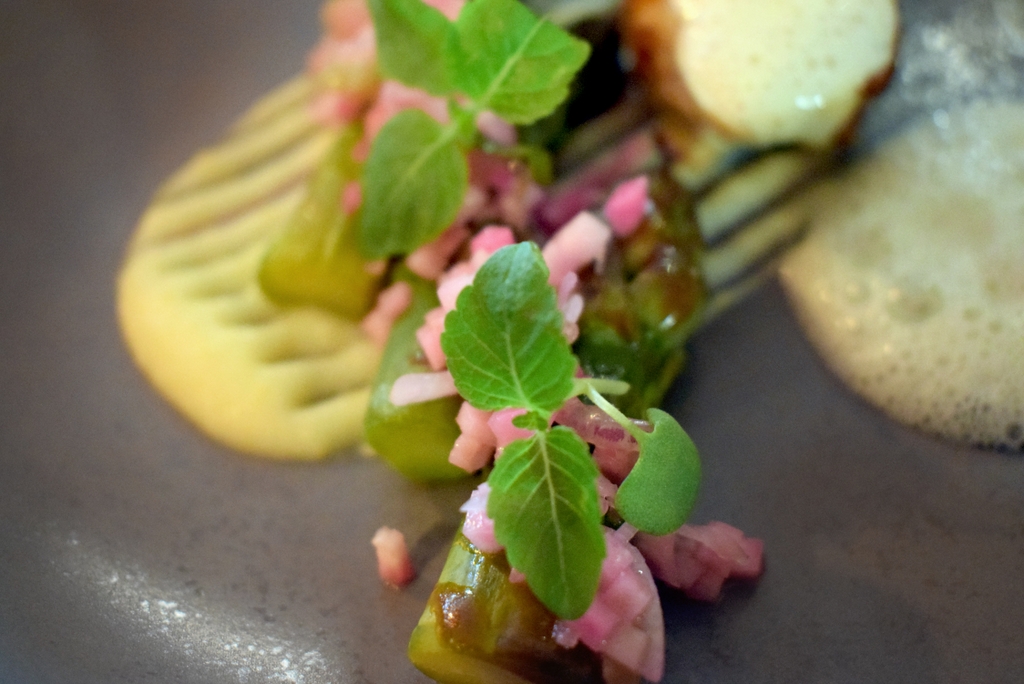
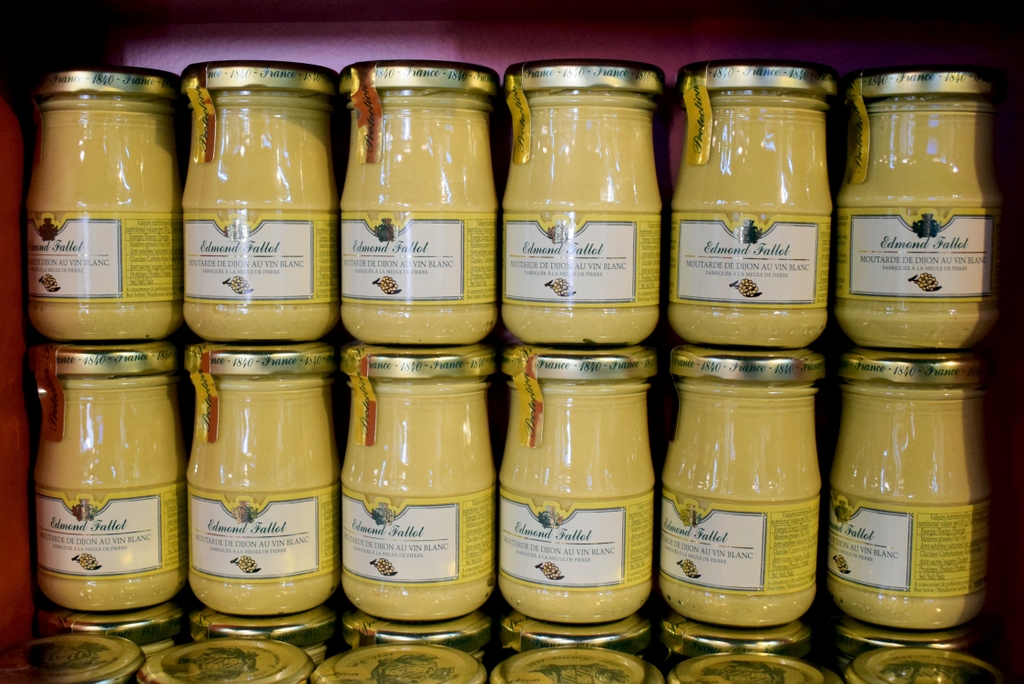
Beaune
35 km to the southeast
The prestigious city of Burgundy wine is also a city of art and history, famous for the court of honour of its Hôtel-Dieu (the Hospices de Beaune).

Beaune is also a city of bourgeois houses, the magnificent Notre-Dame church, museums, the walk along the ramparts…
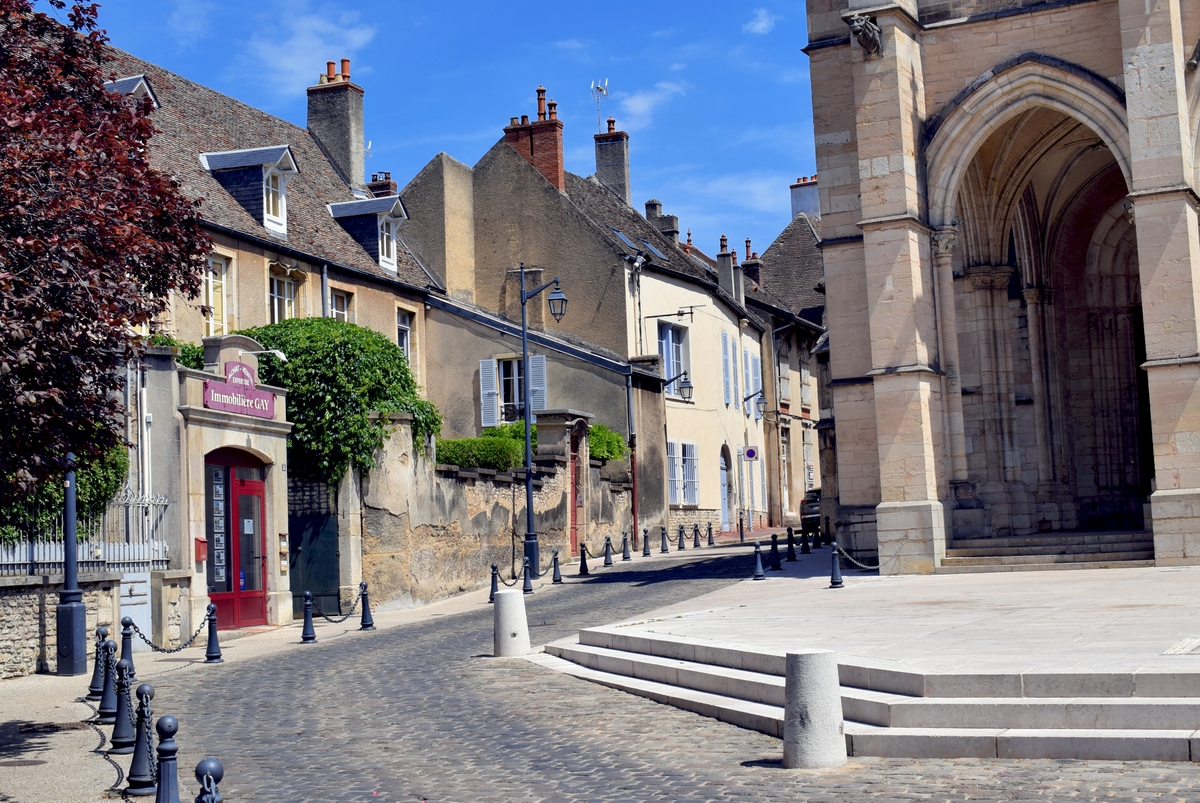

Where to stay in the area?
Châteauneuf is part of the Pays d’Auxois, a rather large rural area in the Côte d’Or, northwest of Dijon. You will find several ideas for accommodation in the Pouilly-en-Auxois area by clicking here. Or, let yourself be guided by the map below:
Booking.com
Find out more about Châteauneuf
Reference sites
- Read this article in French on our blog Mon-Grand-Est
- Discover Meursault near Beaune
- Discover the gastronomy of Dijon
- The Official Website of Châteauneuf-en-Auxois
- Côte d’Or Tourisme to find out more about the touristic destinations in the département 21
- The site of Bourgogne Tourisme
- The article on Wikipedia about the castle of Châteauneuf-en-Auxois (in French)
A Pin for Pinterest

Have you visited rural Burgundy? If so, what are your favourite villages? Tell me all about it in the comments below 🙂



